Health Disparities: Factors, Impacts, and Countermeasures Analysis
VerifiedAdded on 2022/12/27
|9
|2399
|46
Essay
AI Summary
This essay provides an insightful overview of health disparities, exploring the multifaceted factors contributing to these inequities. It begins by highlighting the diverse and multicultural world we live in, emphasizing the importance of equitable access to healthcare. The essay delves into the impact of socioeconomic status, race, ethnicity, and cultural differences on health outcomes, illustrating how these factors can create barriers to quality care. It also examines failures within healthcare systems, the role of biological pathways, and environmental influences. The essay proposes various countermeasures, including improving healthcare access through insurance, developing new healthcare delivery models, promoting patient and community engagement, and transforming primary care to address the medical, social, and behavioral needs of vulnerable populations. It concludes by emphasizing the need for a worldwide commitment to equity through expansive health insurance coverage, public accountability, and resource investment, all focused on patient engagement, healthcare professionals, communities, and healthcare organizations.
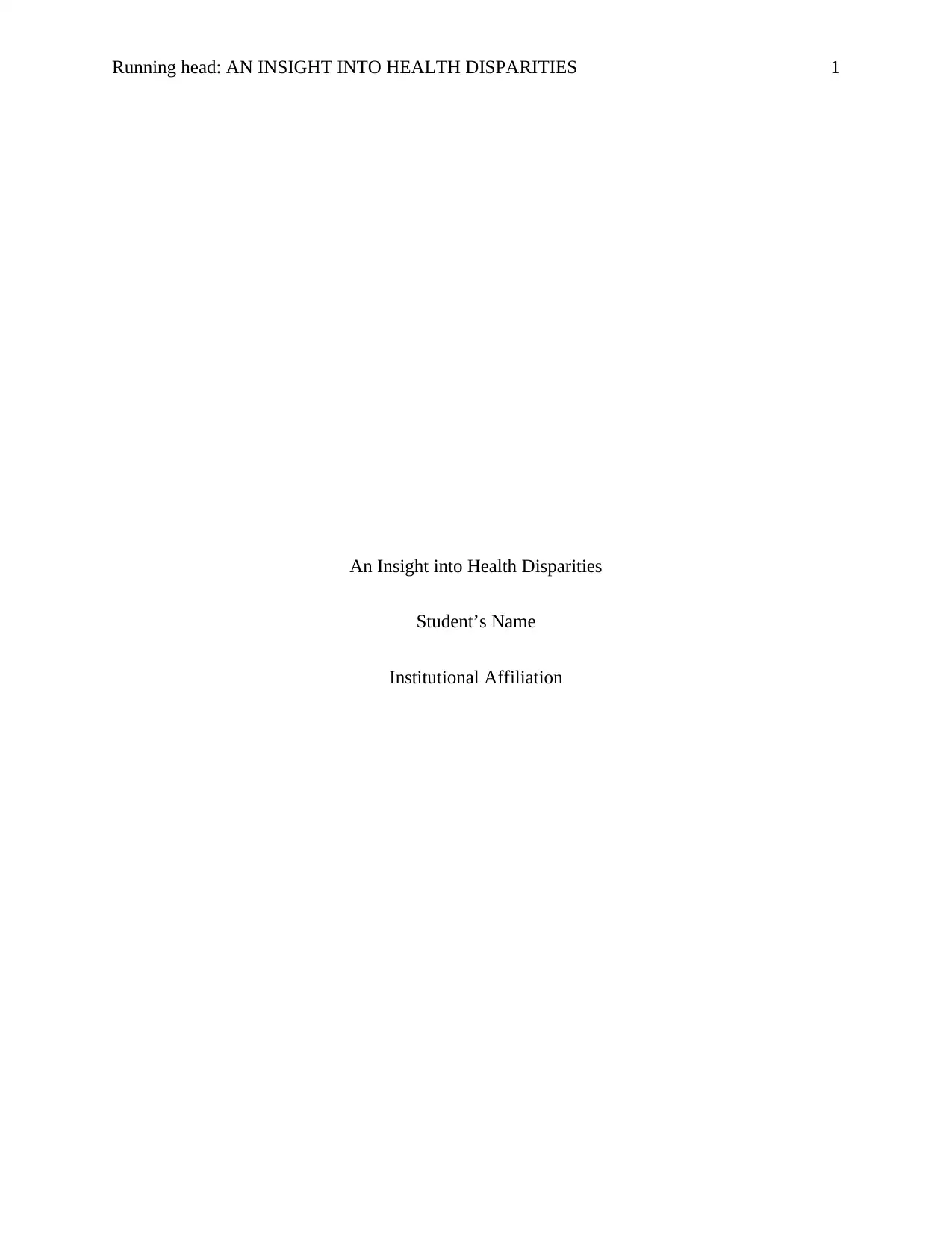
Running head: AN INSIGHT INTO HEALTH DISPARITIES 1
An Insight into Health Disparities
Student’s Name
Institutional Affiliation
An Insight into Health Disparities
Student’s Name
Institutional Affiliation
Paraphrase This Document
Need a fresh take? Get an instant paraphrase of this document with our AI Paraphraser
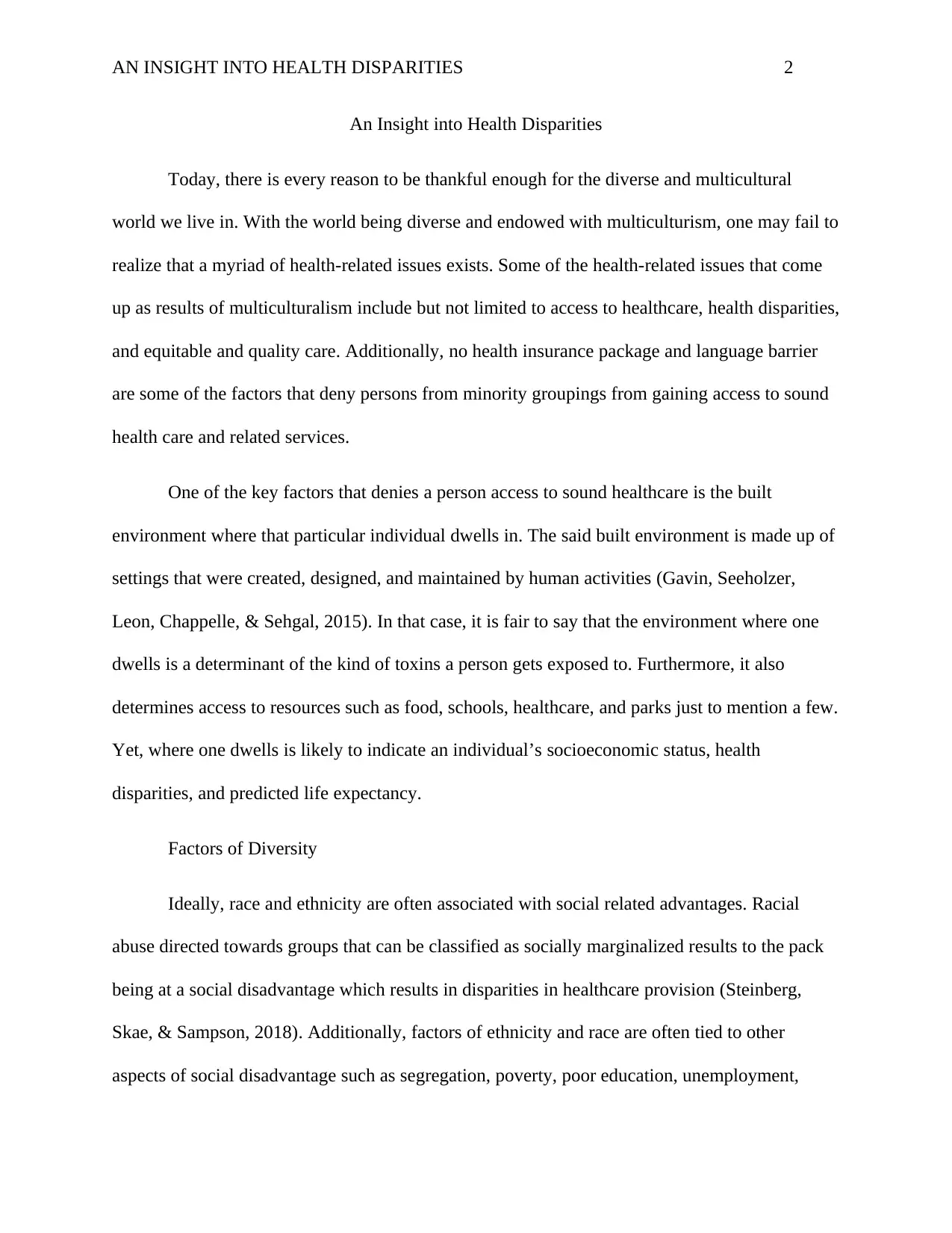
AN INSIGHT INTO HEALTH DISPARITIES 2
An Insight into Health Disparities
Today, there is every reason to be thankful enough for the diverse and multicultural
world we live in. With the world being diverse and endowed with multiculturism, one may fail to
realize that a myriad of health-related issues exists. Some of the health-related issues that come
up as results of multiculturalism include but not limited to access to healthcare, health disparities,
and equitable and quality care. Additionally, no health insurance package and language barrier
are some of the factors that deny persons from minority groupings from gaining access to sound
health care and related services.
One of the key factors that denies a person access to sound healthcare is the built
environment where that particular individual dwells in. The said built environment is made up of
settings that were created, designed, and maintained by human activities (Gavin, Seeholzer,
Leon, Chappelle, & Sehgal, 2015). In that case, it is fair to say that the environment where one
dwells is a determinant of the kind of toxins a person gets exposed to. Furthermore, it also
determines access to resources such as food, schools, healthcare, and parks just to mention a few.
Yet, where one dwells is likely to indicate an individual’s socioeconomic status, health
disparities, and predicted life expectancy.
Factors of Diversity
Ideally, race and ethnicity are often associated with social related advantages. Racial
abuse directed towards groups that can be classified as socially marginalized results to the pack
being at a social disadvantage which results in disparities in healthcare provision (Steinberg,
Skae, & Sampson, 2018). Additionally, factors of ethnicity and race are often tied to other
aspects of social disadvantage such as segregation, poverty, poor education, unemployment,
An Insight into Health Disparities
Today, there is every reason to be thankful enough for the diverse and multicultural
world we live in. With the world being diverse and endowed with multiculturism, one may fail to
realize that a myriad of health-related issues exists. Some of the health-related issues that come
up as results of multiculturalism include but not limited to access to healthcare, health disparities,
and equitable and quality care. Additionally, no health insurance package and language barrier
are some of the factors that deny persons from minority groupings from gaining access to sound
health care and related services.
One of the key factors that denies a person access to sound healthcare is the built
environment where that particular individual dwells in. The said built environment is made up of
settings that were created, designed, and maintained by human activities (Gavin, Seeholzer,
Leon, Chappelle, & Sehgal, 2015). In that case, it is fair to say that the environment where one
dwells is a determinant of the kind of toxins a person gets exposed to. Furthermore, it also
determines access to resources such as food, schools, healthcare, and parks just to mention a few.
Yet, where one dwells is likely to indicate an individual’s socioeconomic status, health
disparities, and predicted life expectancy.
Factors of Diversity
Ideally, race and ethnicity are often associated with social related advantages. Racial
abuse directed towards groups that can be classified as socially marginalized results to the pack
being at a social disadvantage which results in disparities in healthcare provision (Steinberg,
Skae, & Sampson, 2018). Additionally, factors of ethnicity and race are often tied to other
aspects of social disadvantage such as segregation, poverty, poor education, unemployment,
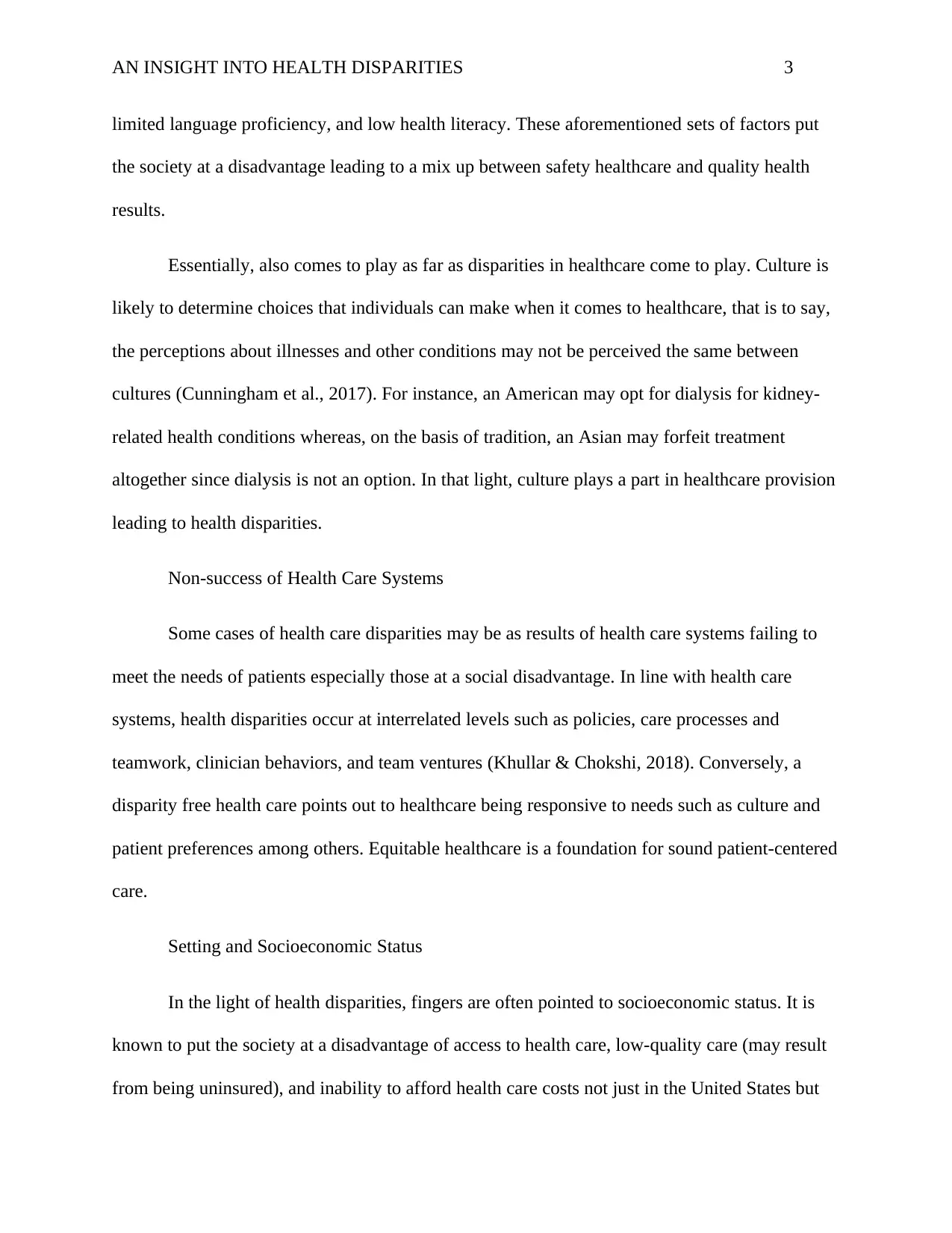
AN INSIGHT INTO HEALTH DISPARITIES 3
limited language proficiency, and low health literacy. These aforementioned sets of factors put
the society at a disadvantage leading to a mix up between safety healthcare and quality health
results.
Essentially, also comes to play as far as disparities in healthcare come to play. Culture is
likely to determine choices that individuals can make when it comes to healthcare, that is to say,
the perceptions about illnesses and other conditions may not be perceived the same between
cultures (Cunningham et al., 2017). For instance, an American may opt for dialysis for kidney-
related health conditions whereas, on the basis of tradition, an Asian may forfeit treatment
altogether since dialysis is not an option. In that light, culture plays a part in healthcare provision
leading to health disparities.
Non-success of Health Care Systems
Some cases of health care disparities may be as results of health care systems failing to
meet the needs of patients especially those at a social disadvantage. In line with health care
systems, health disparities occur at interrelated levels such as policies, care processes and
teamwork, clinician behaviors, and team ventures (Khullar & Chokshi, 2018). Conversely, a
disparity free health care points out to healthcare being responsive to needs such as culture and
patient preferences among others. Equitable healthcare is a foundation for sound patient-centered
care.
Setting and Socioeconomic Status
In the light of health disparities, fingers are often pointed to socioeconomic status. It is
known to put the society at a disadvantage of access to health care, low-quality care (may result
from being uninsured), and inability to afford health care costs not just in the United States but
limited language proficiency, and low health literacy. These aforementioned sets of factors put
the society at a disadvantage leading to a mix up between safety healthcare and quality health
results.
Essentially, also comes to play as far as disparities in healthcare come to play. Culture is
likely to determine choices that individuals can make when it comes to healthcare, that is to say,
the perceptions about illnesses and other conditions may not be perceived the same between
cultures (Cunningham et al., 2017). For instance, an American may opt for dialysis for kidney-
related health conditions whereas, on the basis of tradition, an Asian may forfeit treatment
altogether since dialysis is not an option. In that light, culture plays a part in healthcare provision
leading to health disparities.
Non-success of Health Care Systems
Some cases of health care disparities may be as results of health care systems failing to
meet the needs of patients especially those at a social disadvantage. In line with health care
systems, health disparities occur at interrelated levels such as policies, care processes and
teamwork, clinician behaviors, and team ventures (Khullar & Chokshi, 2018). Conversely, a
disparity free health care points out to healthcare being responsive to needs such as culture and
patient preferences among others. Equitable healthcare is a foundation for sound patient-centered
care.
Setting and Socioeconomic Status
In the light of health disparities, fingers are often pointed to socioeconomic status. It is
known to put the society at a disadvantage of access to health care, low-quality care (may result
from being uninsured), and inability to afford health care costs not just in the United States but
⊘ This is a preview!⊘
Do you want full access?
Subscribe today to unlock all pages.

Trusted by 1+ million students worldwide
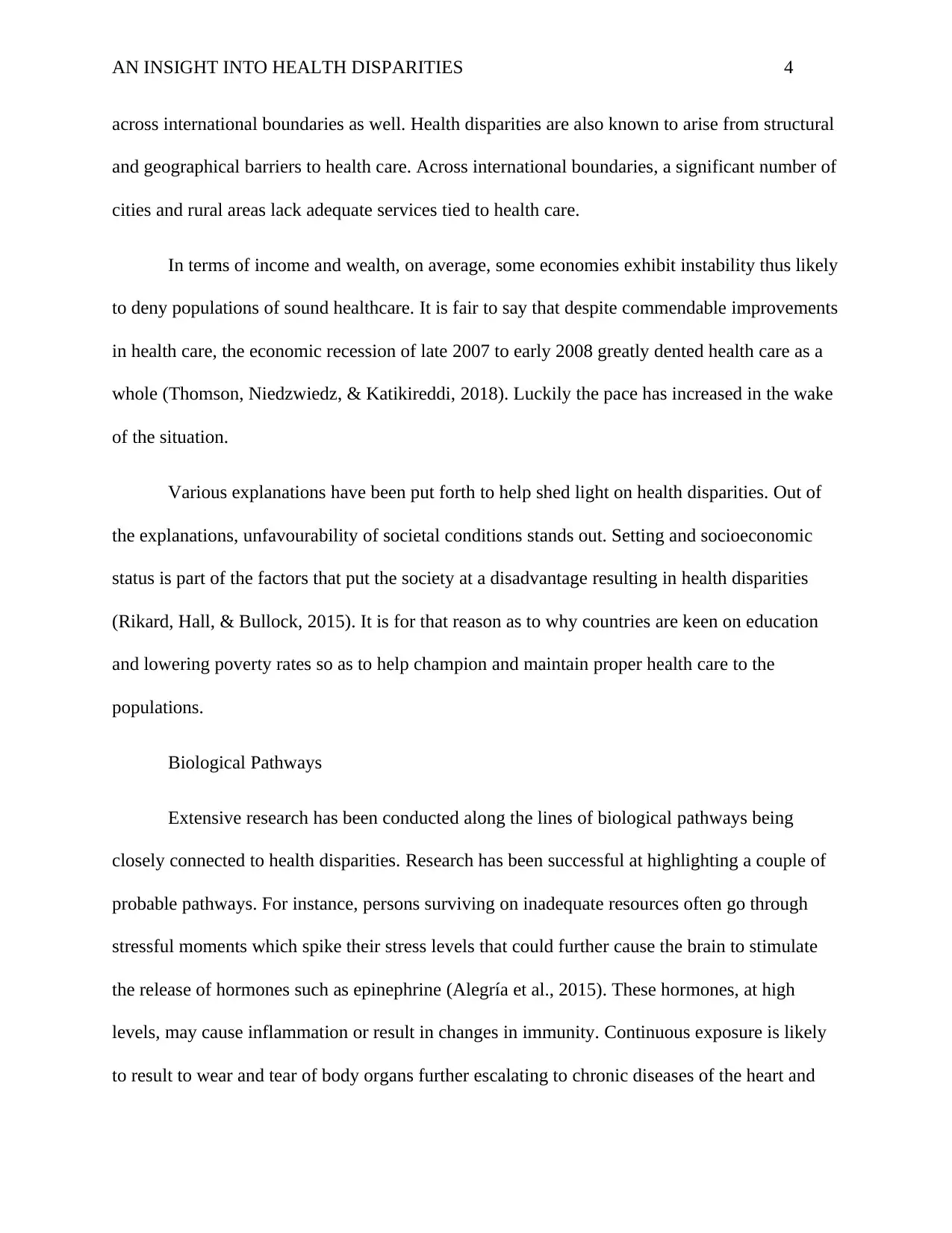
AN INSIGHT INTO HEALTH DISPARITIES 4
across international boundaries as well. Health disparities are also known to arise from structural
and geographical barriers to health care. Across international boundaries, a significant number of
cities and rural areas lack adequate services tied to health care.
In terms of income and wealth, on average, some economies exhibit instability thus likely
to deny populations of sound healthcare. It is fair to say that despite commendable improvements
in health care, the economic recession of late 2007 to early 2008 greatly dented health care as a
whole (Thomson, Niedzwiedz, & Katikireddi, 2018). Luckily the pace has increased in the wake
of the situation.
Various explanations have been put forth to help shed light on health disparities. Out of
the explanations, unfavourability of societal conditions stands out. Setting and socioeconomic
status is part of the factors that put the society at a disadvantage resulting in health disparities
(Rikard, Hall, & Bullock, 2015). It is for that reason as to why countries are keen on education
and lowering poverty rates so as to help champion and maintain proper health care to the
populations.
Biological Pathways
Extensive research has been conducted along the lines of biological pathways being
closely connected to health disparities. Research has been successful at highlighting a couple of
probable pathways. For instance, persons surviving on inadequate resources often go through
stressful moments which spike their stress levels that could further cause the brain to stimulate
the release of hormones such as epinephrine (Alegría et al., 2015). These hormones, at high
levels, may cause inflammation or result in changes in immunity. Continuous exposure is likely
to result to wear and tear of body organs further escalating to chronic diseases of the heart and
across international boundaries as well. Health disparities are also known to arise from structural
and geographical barriers to health care. Across international boundaries, a significant number of
cities and rural areas lack adequate services tied to health care.
In terms of income and wealth, on average, some economies exhibit instability thus likely
to deny populations of sound healthcare. It is fair to say that despite commendable improvements
in health care, the economic recession of late 2007 to early 2008 greatly dented health care as a
whole (Thomson, Niedzwiedz, & Katikireddi, 2018). Luckily the pace has increased in the wake
of the situation.
Various explanations have been put forth to help shed light on health disparities. Out of
the explanations, unfavourability of societal conditions stands out. Setting and socioeconomic
status is part of the factors that put the society at a disadvantage resulting in health disparities
(Rikard, Hall, & Bullock, 2015). It is for that reason as to why countries are keen on education
and lowering poverty rates so as to help champion and maintain proper health care to the
populations.
Biological Pathways
Extensive research has been conducted along the lines of biological pathways being
closely connected to health disparities. Research has been successful at highlighting a couple of
probable pathways. For instance, persons surviving on inadequate resources often go through
stressful moments which spike their stress levels that could further cause the brain to stimulate
the release of hormones such as epinephrine (Alegría et al., 2015). These hormones, at high
levels, may cause inflammation or result in changes in immunity. Continuous exposure is likely
to result to wear and tear of body organs further escalating to chronic diseases of the heart and
Paraphrase This Document
Need a fresh take? Get an instant paraphrase of this document with our AI Paraphraser
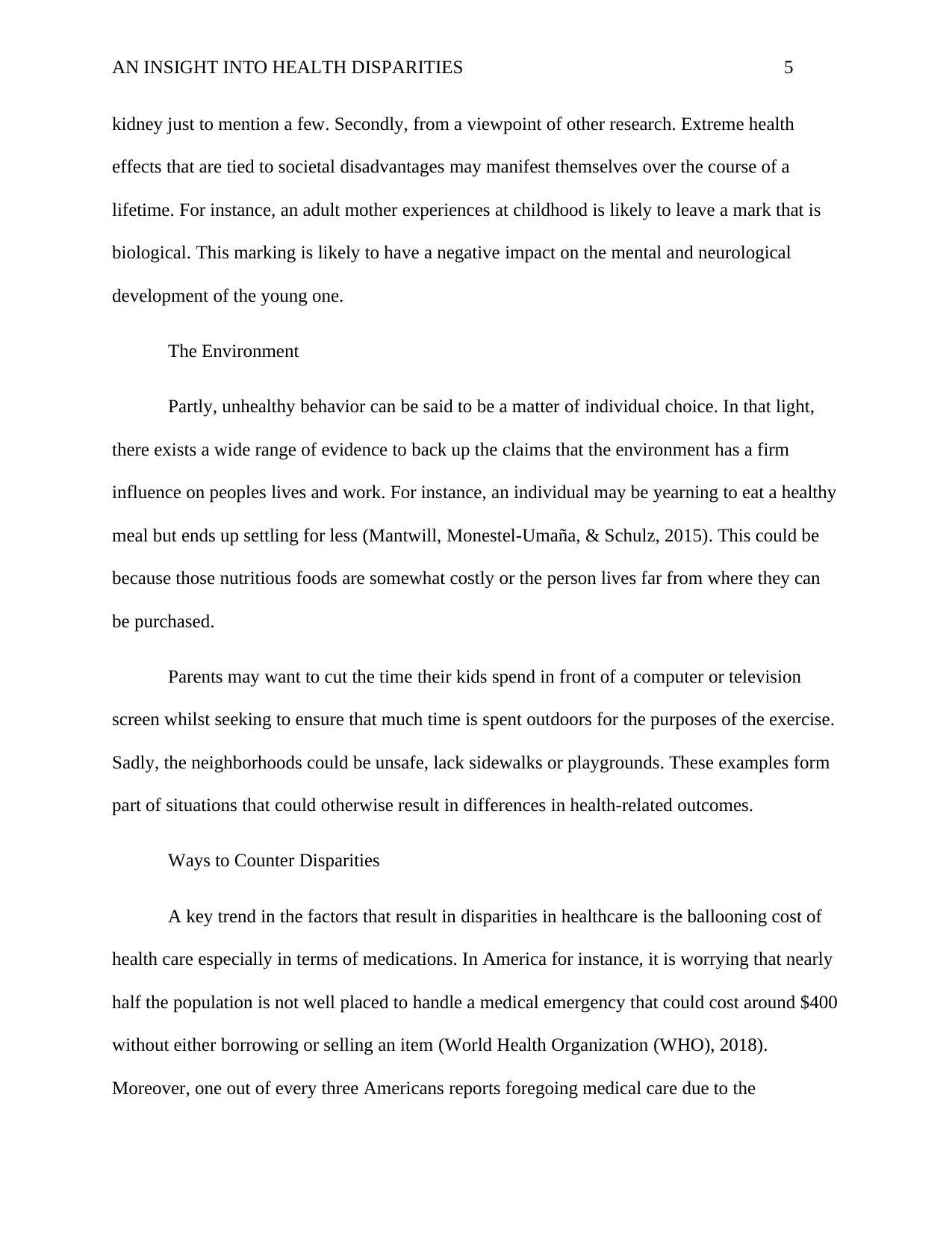
AN INSIGHT INTO HEALTH DISPARITIES 5
kidney just to mention a few. Secondly, from a viewpoint of other research. Extreme health
effects that are tied to societal disadvantages may manifest themselves over the course of a
lifetime. For instance, an adult mother experiences at childhood is likely to leave a mark that is
biological. This marking is likely to have a negative impact on the mental and neurological
development of the young one.
The Environment
Partly, unhealthy behavior can be said to be a matter of individual choice. In that light,
there exists a wide range of evidence to back up the claims that the environment has a firm
influence on peoples lives and work. For instance, an individual may be yearning to eat a healthy
meal but ends up settling for less (Mantwill, Monestel-Umaña, & Schulz, 2015). This could be
because those nutritious foods are somewhat costly or the person lives far from where they can
be purchased.
Parents may want to cut the time their kids spend in front of a computer or television
screen whilst seeking to ensure that much time is spent outdoors for the purposes of the exercise.
Sadly, the neighborhoods could be unsafe, lack sidewalks or playgrounds. These examples form
part of situations that could otherwise result in differences in health-related outcomes.
Ways to Counter Disparities
A key trend in the factors that result in disparities in healthcare is the ballooning cost of
health care especially in terms of medications. In America for instance, it is worrying that nearly
half the population is not well placed to handle a medical emergency that could cost around $400
without either borrowing or selling an item (World Health Organization (WHO), 2018).
Moreover, one out of every three Americans reports foregoing medical care due to the
kidney just to mention a few. Secondly, from a viewpoint of other research. Extreme health
effects that are tied to societal disadvantages may manifest themselves over the course of a
lifetime. For instance, an adult mother experiences at childhood is likely to leave a mark that is
biological. This marking is likely to have a negative impact on the mental and neurological
development of the young one.
The Environment
Partly, unhealthy behavior can be said to be a matter of individual choice. In that light,
there exists a wide range of evidence to back up the claims that the environment has a firm
influence on peoples lives and work. For instance, an individual may be yearning to eat a healthy
meal but ends up settling for less (Mantwill, Monestel-Umaña, & Schulz, 2015). This could be
because those nutritious foods are somewhat costly or the person lives far from where they can
be purchased.
Parents may want to cut the time their kids spend in front of a computer or television
screen whilst seeking to ensure that much time is spent outdoors for the purposes of the exercise.
Sadly, the neighborhoods could be unsafe, lack sidewalks or playgrounds. These examples form
part of situations that could otherwise result in differences in health-related outcomes.
Ways to Counter Disparities
A key trend in the factors that result in disparities in healthcare is the ballooning cost of
health care especially in terms of medications. In America for instance, it is worrying that nearly
half the population is not well placed to handle a medical emergency that could cost around $400
without either borrowing or selling an item (World Health Organization (WHO), 2018).
Moreover, one out of every three Americans reports foregoing medical care due to the
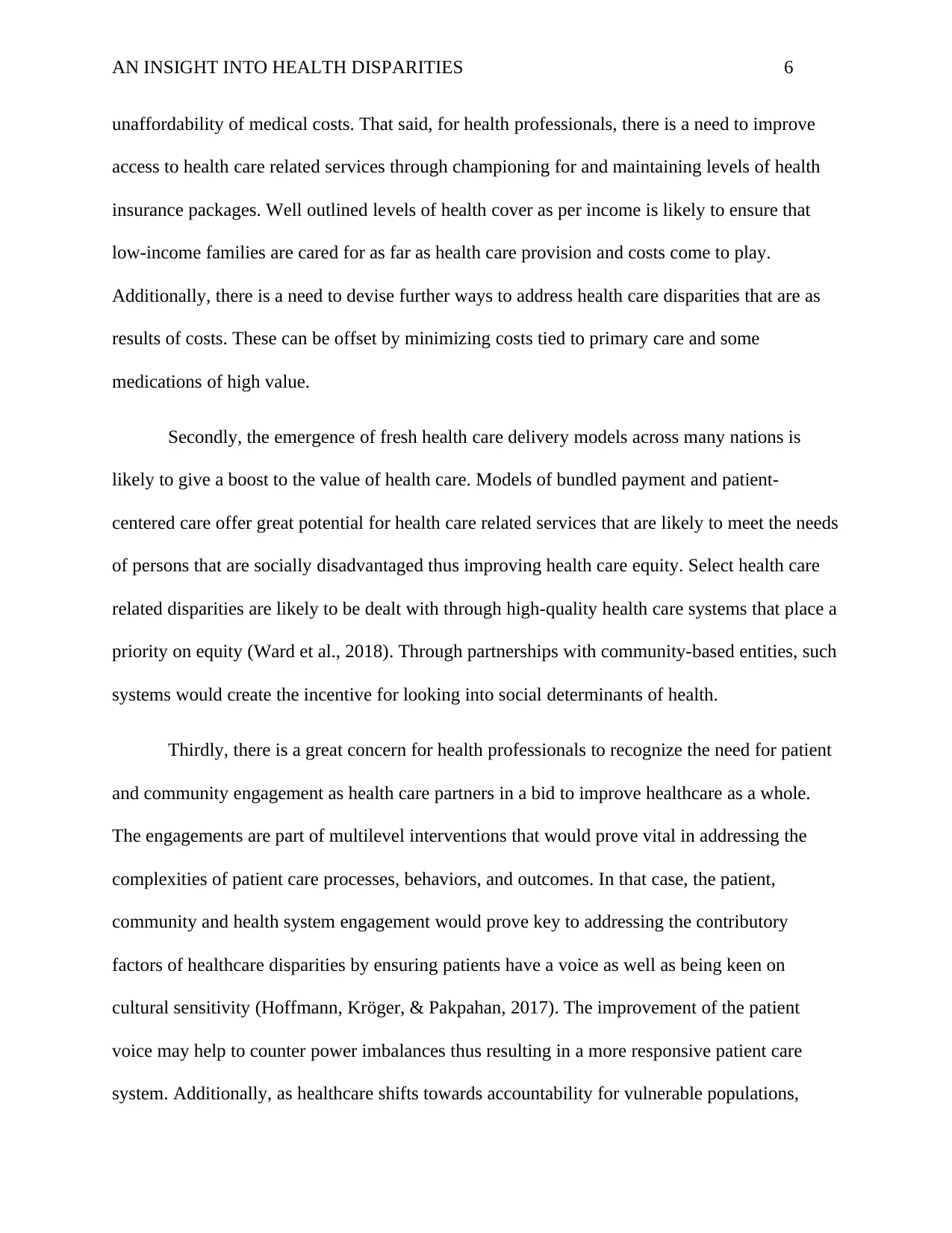
AN INSIGHT INTO HEALTH DISPARITIES 6
unaffordability of medical costs. That said, for health professionals, there is a need to improve
access to health care related services through championing for and maintaining levels of health
insurance packages. Well outlined levels of health cover as per income is likely to ensure that
low-income families are cared for as far as health care provision and costs come to play.
Additionally, there is a need to devise further ways to address health care disparities that are as
results of costs. These can be offset by minimizing costs tied to primary care and some
medications of high value.
Secondly, the emergence of fresh health care delivery models across many nations is
likely to give a boost to the value of health care. Models of bundled payment and patient-
centered care offer great potential for health care related services that are likely to meet the needs
of persons that are socially disadvantaged thus improving health care equity. Select health care
related disparities are likely to be dealt with through high-quality health care systems that place a
priority on equity (Ward et al., 2018). Through partnerships with community-based entities, such
systems would create the incentive for looking into social determinants of health.
Thirdly, there is a great concern for health professionals to recognize the need for patient
and community engagement as health care partners in a bid to improve healthcare as a whole.
The engagements are part of multilevel interventions that would prove vital in addressing the
complexities of patient care processes, behaviors, and outcomes. In that case, the patient,
community and health system engagement would prove key to addressing the contributory
factors of healthcare disparities by ensuring patients have a voice as well as being keen on
cultural sensitivity (Hoffmann, Kröger, & Pakpahan, 2017). The improvement of the patient
voice may help to counter power imbalances thus resulting in a more responsive patient care
system. Additionally, as healthcare shifts towards accountability for vulnerable populations,
unaffordability of medical costs. That said, for health professionals, there is a need to improve
access to health care related services through championing for and maintaining levels of health
insurance packages. Well outlined levels of health cover as per income is likely to ensure that
low-income families are cared for as far as health care provision and costs come to play.
Additionally, there is a need to devise further ways to address health care disparities that are as
results of costs. These can be offset by minimizing costs tied to primary care and some
medications of high value.
Secondly, the emergence of fresh health care delivery models across many nations is
likely to give a boost to the value of health care. Models of bundled payment and patient-
centered care offer great potential for health care related services that are likely to meet the needs
of persons that are socially disadvantaged thus improving health care equity. Select health care
related disparities are likely to be dealt with through high-quality health care systems that place a
priority on equity (Ward et al., 2018). Through partnerships with community-based entities, such
systems would create the incentive for looking into social determinants of health.
Thirdly, there is a great concern for health professionals to recognize the need for patient
and community engagement as health care partners in a bid to improve healthcare as a whole.
The engagements are part of multilevel interventions that would prove vital in addressing the
complexities of patient care processes, behaviors, and outcomes. In that case, the patient,
community and health system engagement would prove key to addressing the contributory
factors of healthcare disparities by ensuring patients have a voice as well as being keen on
cultural sensitivity (Hoffmann, Kröger, & Pakpahan, 2017). The improvement of the patient
voice may help to counter power imbalances thus resulting in a more responsive patient care
system. Additionally, as healthcare shifts towards accountability for vulnerable populations,
⊘ This is a preview!⊘
Do you want full access?
Subscribe today to unlock all pages.

Trusted by 1+ million students worldwide
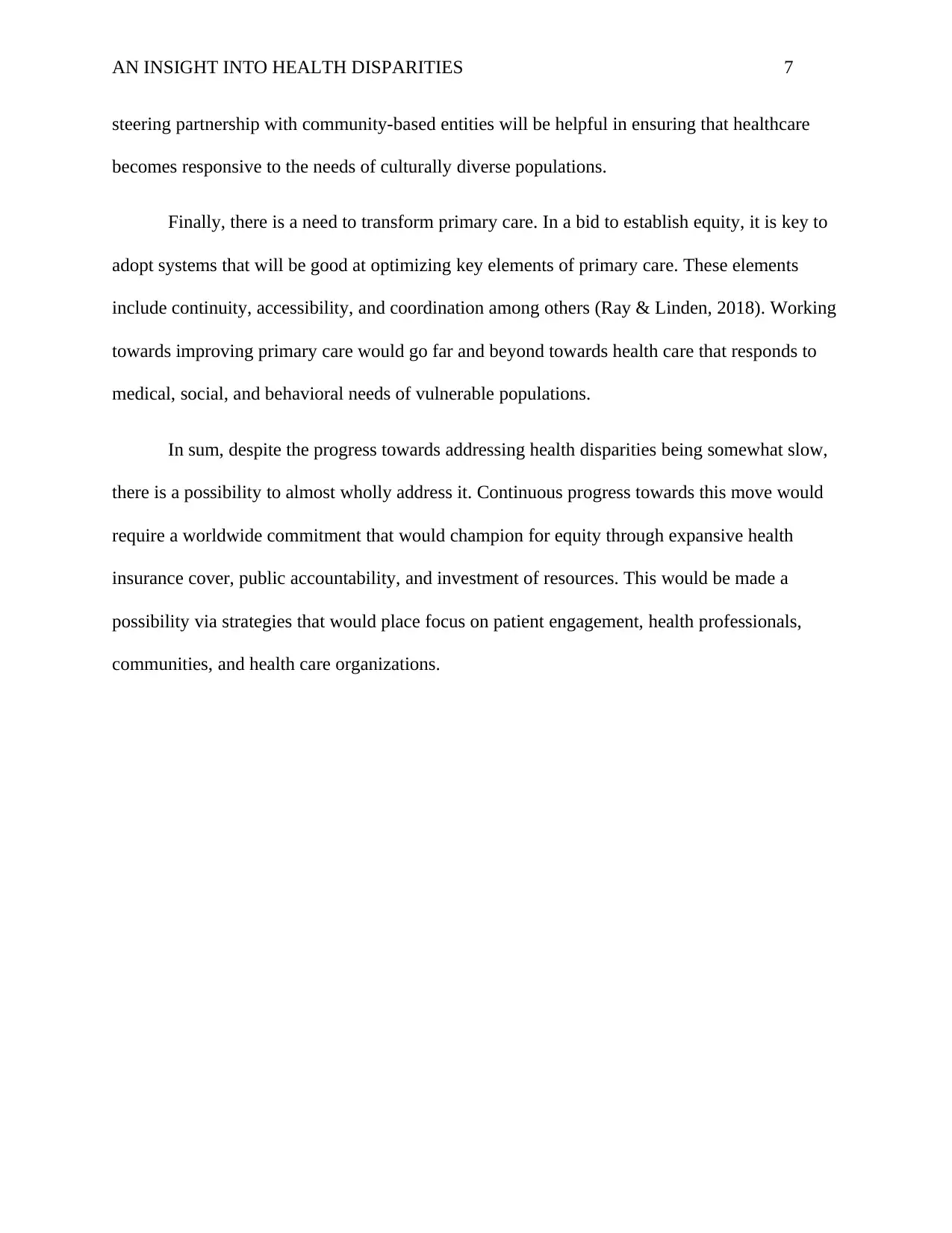
AN INSIGHT INTO HEALTH DISPARITIES 7
steering partnership with community-based entities will be helpful in ensuring that healthcare
becomes responsive to the needs of culturally diverse populations.
Finally, there is a need to transform primary care. In a bid to establish equity, it is key to
adopt systems that will be good at optimizing key elements of primary care. These elements
include continuity, accessibility, and coordination among others (Ray & Linden, 2018). Working
towards improving primary care would go far and beyond towards health care that responds to
medical, social, and behavioral needs of vulnerable populations.
In sum, despite the progress towards addressing health disparities being somewhat slow,
there is a possibility to almost wholly address it. Continuous progress towards this move would
require a worldwide commitment that would champion for equity through expansive health
insurance cover, public accountability, and investment of resources. This would be made a
possibility via strategies that would place focus on patient engagement, health professionals,
communities, and health care organizations.
steering partnership with community-based entities will be helpful in ensuring that healthcare
becomes responsive to the needs of culturally diverse populations.
Finally, there is a need to transform primary care. In a bid to establish equity, it is key to
adopt systems that will be good at optimizing key elements of primary care. These elements
include continuity, accessibility, and coordination among others (Ray & Linden, 2018). Working
towards improving primary care would go far and beyond towards health care that responds to
medical, social, and behavioral needs of vulnerable populations.
In sum, despite the progress towards addressing health disparities being somewhat slow,
there is a possibility to almost wholly address it. Continuous progress towards this move would
require a worldwide commitment that would champion for equity through expansive health
insurance cover, public accountability, and investment of resources. This would be made a
possibility via strategies that would place focus on patient engagement, health professionals,
communities, and health care organizations.
Paraphrase This Document
Need a fresh take? Get an instant paraphrase of this document with our AI Paraphraser
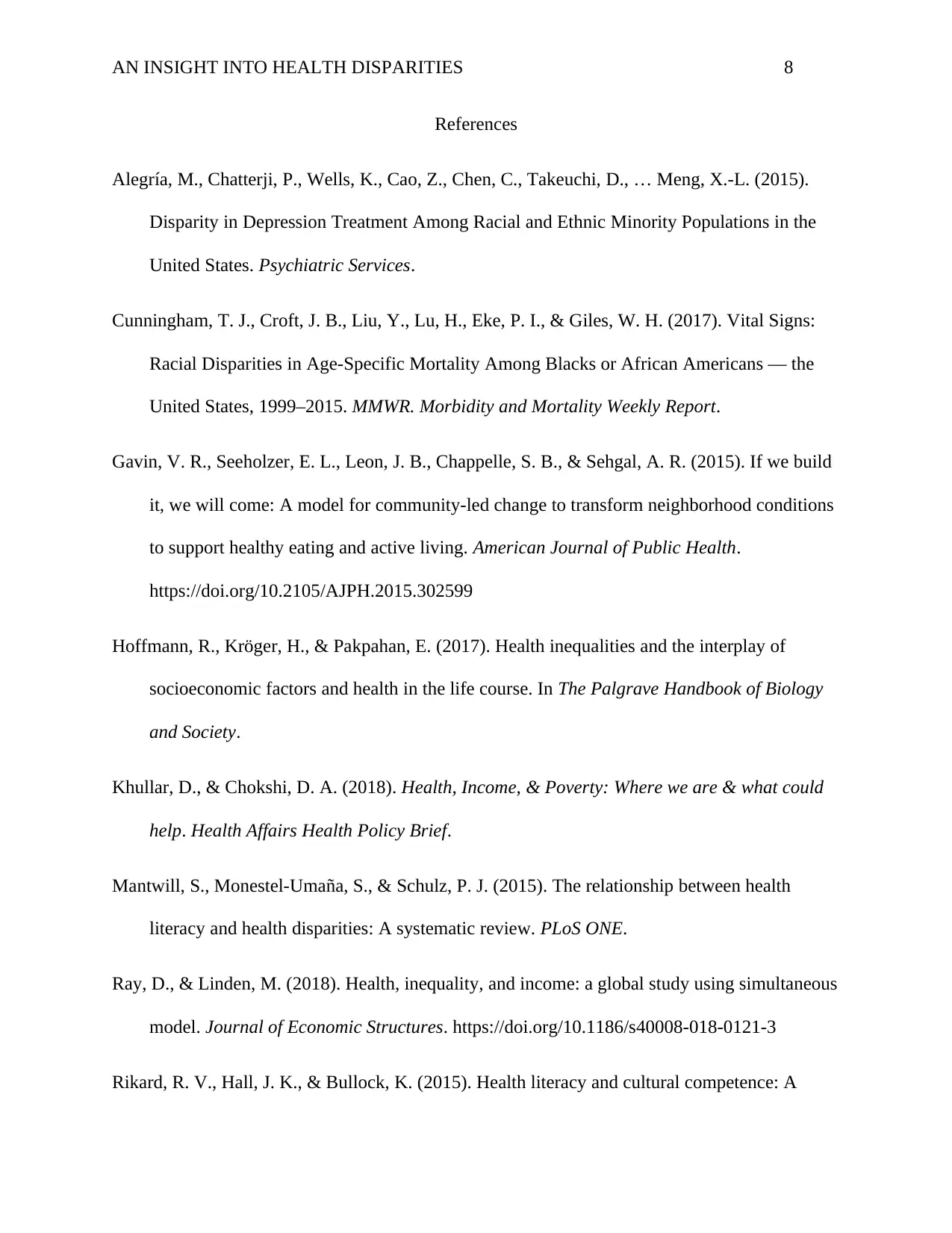
AN INSIGHT INTO HEALTH DISPARITIES 8
References
Alegría, M., Chatterji, P., Wells, K., Cao, Z., Chen, C., Takeuchi, D., … Meng, X.-L. (2015).
Disparity in Depression Treatment Among Racial and Ethnic Minority Populations in the
United States. Psychiatric Services.
Cunningham, T. J., Croft, J. B., Liu, Y., Lu, H., Eke, P. I., & Giles, W. H. (2017). Vital Signs:
Racial Disparities in Age-Specific Mortality Among Blacks or African Americans — the
United States, 1999–2015. MMWR. Morbidity and Mortality Weekly Report.
Gavin, V. R., Seeholzer, E. L., Leon, J. B., Chappelle, S. B., & Sehgal, A. R. (2015). If we build
it, we will come: A model for community-led change to transform neighborhood conditions
to support healthy eating and active living. American Journal of Public Health.
https://doi.org/10.2105/AJPH.2015.302599
Hoffmann, R., Kröger, H., & Pakpahan, E. (2017). Health inequalities and the interplay of
socioeconomic factors and health in the life course. In The Palgrave Handbook of Biology
and Society.
Khullar, D., & Chokshi, D. A. (2018). Health, Income, & Poverty: Where we are & what could
help. Health Affairs Health Policy Brief.
Mantwill, S., Monestel-Umaña, S., & Schulz, P. J. (2015). The relationship between health
literacy and health disparities: A systematic review. PLoS ONE.
Ray, D., & Linden, M. (2018). Health, inequality, and income: a global study using simultaneous
model. Journal of Economic Structures. https://doi.org/10.1186/s40008-018-0121-3
Rikard, R. V., Hall, J. K., & Bullock, K. (2015). Health literacy and cultural competence: A
References
Alegría, M., Chatterji, P., Wells, K., Cao, Z., Chen, C., Takeuchi, D., … Meng, X.-L. (2015).
Disparity in Depression Treatment Among Racial and Ethnic Minority Populations in the
United States. Psychiatric Services.
Cunningham, T. J., Croft, J. B., Liu, Y., Lu, H., Eke, P. I., & Giles, W. H. (2017). Vital Signs:
Racial Disparities in Age-Specific Mortality Among Blacks or African Americans — the
United States, 1999–2015. MMWR. Morbidity and Mortality Weekly Report.
Gavin, V. R., Seeholzer, E. L., Leon, J. B., Chappelle, S. B., & Sehgal, A. R. (2015). If we build
it, we will come: A model for community-led change to transform neighborhood conditions
to support healthy eating and active living. American Journal of Public Health.
https://doi.org/10.2105/AJPH.2015.302599
Hoffmann, R., Kröger, H., & Pakpahan, E. (2017). Health inequalities and the interplay of
socioeconomic factors and health in the life course. In The Palgrave Handbook of Biology
and Society.
Khullar, D., & Chokshi, D. A. (2018). Health, Income, & Poverty: Where we are & what could
help. Health Affairs Health Policy Brief.
Mantwill, S., Monestel-Umaña, S., & Schulz, P. J. (2015). The relationship between health
literacy and health disparities: A systematic review. PLoS ONE.
Ray, D., & Linden, M. (2018). Health, inequality, and income: a global study using simultaneous
model. Journal of Economic Structures. https://doi.org/10.1186/s40008-018-0121-3
Rikard, R. V., Hall, J. K., & Bullock, K. (2015). Health literacy and cultural competence: A
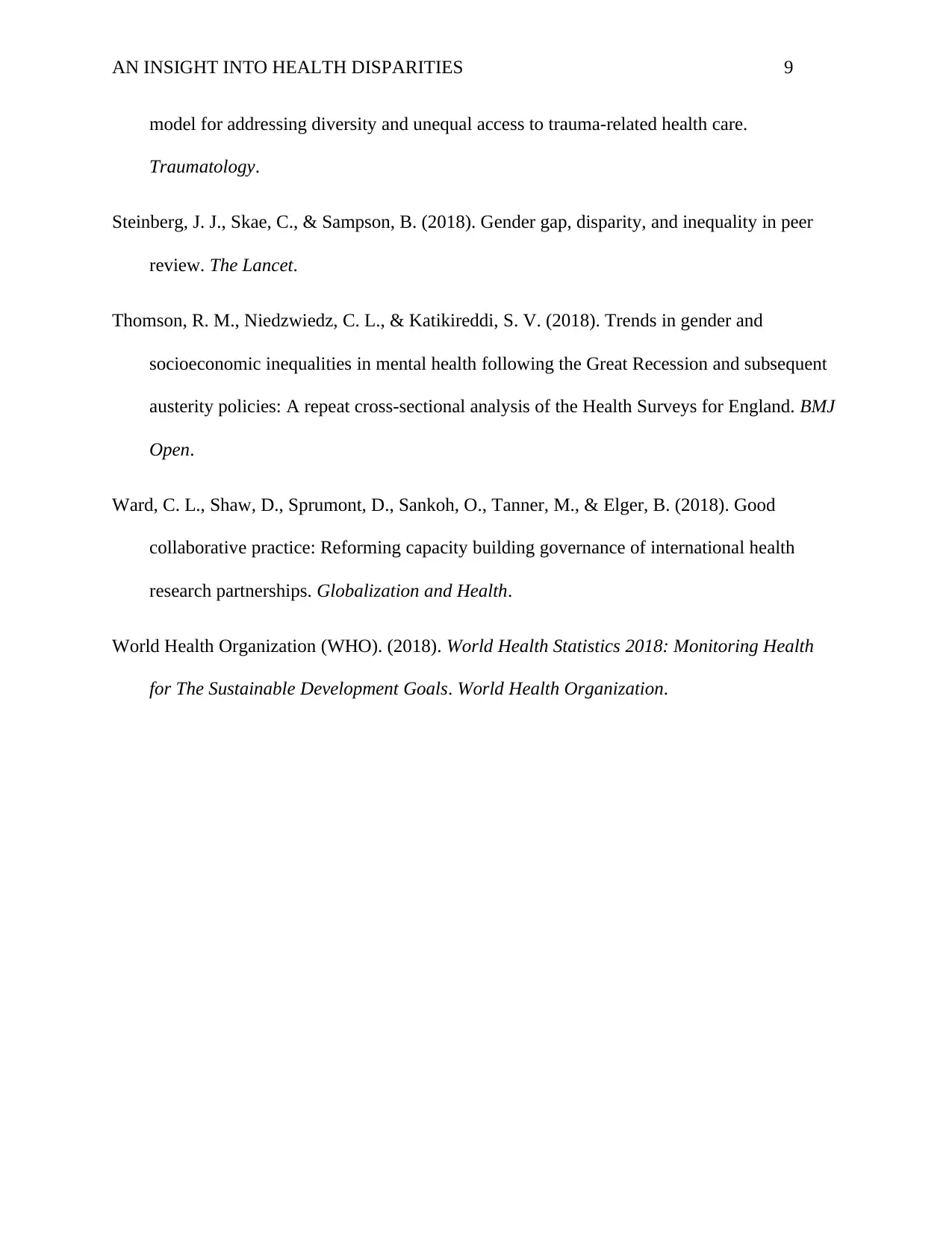
AN INSIGHT INTO HEALTH DISPARITIES 9
model for addressing diversity and unequal access to trauma-related health care.
Traumatology.
Steinberg, J. J., Skae, C., & Sampson, B. (2018). Gender gap, disparity, and inequality in peer
review. The Lancet.
Thomson, R. M., Niedzwiedz, C. L., & Katikireddi, S. V. (2018). Trends in gender and
socioeconomic inequalities in mental health following the Great Recession and subsequent
austerity policies: A repeat cross-sectional analysis of the Health Surveys for England. BMJ
Open.
Ward, C. L., Shaw, D., Sprumont, D., Sankoh, O., Tanner, M., & Elger, B. (2018). Good
collaborative practice: Reforming capacity building governance of international health
research partnerships. Globalization and Health.
World Health Organization (WHO). (2018). World Health Statistics 2018: Monitoring Health
for The Sustainable Development Goals. World Health Organization.
model for addressing diversity and unequal access to trauma-related health care.
Traumatology.
Steinberg, J. J., Skae, C., & Sampson, B. (2018). Gender gap, disparity, and inequality in peer
review. The Lancet.
Thomson, R. M., Niedzwiedz, C. L., & Katikireddi, S. V. (2018). Trends in gender and
socioeconomic inequalities in mental health following the Great Recession and subsequent
austerity policies: A repeat cross-sectional analysis of the Health Surveys for England. BMJ
Open.
Ward, C. L., Shaw, D., Sprumont, D., Sankoh, O., Tanner, M., & Elger, B. (2018). Good
collaborative practice: Reforming capacity building governance of international health
research partnerships. Globalization and Health.
World Health Organization (WHO). (2018). World Health Statistics 2018: Monitoring Health
for The Sustainable Development Goals. World Health Organization.
⊘ This is a preview!⊘
Do you want full access?
Subscribe today to unlock all pages.

Trusted by 1+ million students worldwide
1 out of 9
Related Documents
Your All-in-One AI-Powered Toolkit for Academic Success.
+13062052269
info@desklib.com
Available 24*7 on WhatsApp / Email
![[object Object]](/_next/static/media/star-bottom.7253800d.svg)
Unlock your academic potential
Copyright © 2020–2025 A2Z Services. All Rights Reserved. Developed and managed by ZUCOL.



